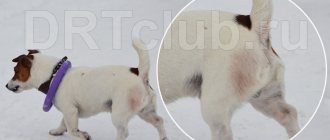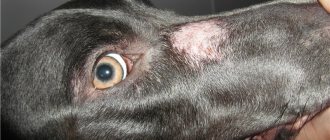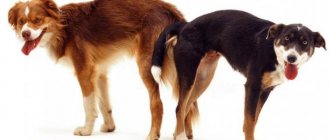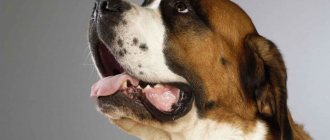Itchy ears in dogs is an extremely unpleasant thing. Owners often call it “ear mange.” The ears may itch deep inside, and no matter what the dog does, the unpleasant sensation does not go away. The dog can scratch its ears with its front and hind paws, rub its head on the carpet, furniture, and people. If you see that your pet is often and intensively trying to “help” you scratch, jerking its back paw when you pat it behind the ear, as if it were scratching itself, welcome to see a veterinarian. If the itching is severe, the dog may scratch his ears until they bleed. It is better not to let this happen and take action at the first signs of illness. It is always easier to prevent a disease than to treat it, and an examination by a doctor is never superfluous.
Diagnostics
Only a veterinarian can make a diagnosis based on anamnesis (collection of information about the pet’s lifestyle), examination and additional research. For example, otoscopy of the middle and inner ear will make it clear where the inflammatory process is localized, and microscopy of the discharge from the auricle will show what exactly could cause the inflammation.
What symptoms may bother your dog besides itching:
- pain - the dog will whine and actively rub its ear with its paws, tilting its head. Trying to look may cause anxiety, discomfort or aggression on the part of the animal;
- a “squelching” sound when pressing on the base of the ear or when the dog shakes its head;
- local redness of the skin, swelling;
- discharge from the ear that is black, gray, yellow or off-white;
- foul odor from the ears;
- enlarged submandibular lymph nodes, general depressed condition of the dog, lethargy;
Each of these symptoms indicates that something is wrong with your ears. The solution to the problem must be approached comprehensively and as quickly as possible.
Itchy ear - what could it be?
Otohematoma
Otohematoma is an accumulation of blood between the ear cartilage and the skin. It rarely causes itching, but it causes obvious discomfort to the four-legged friend - the dog whines and shakes its head. You will not confuse this disease with anything - the dog’s ear looks like an inflated hot balloon. The cause is damage to a blood or lymphatic vessel (capillary) due to injury. Dogs with floppy ears are predisposed to the appearance of otohematoma, but straight-eared breeds can also suffer. Often, an ear hematoma can occur due to itching, when the dog often scratches its ears, hitting the ear with its paw.
Treatment of otohematoma is usually surgical - drainage is installed at the site of the hematoma, and the skin is sutured to the cartilage.
At what age should ears stand up?
Natural setting occurs due to the compaction of the cartilage. The recommended age varies between 2-5 months and depends on the breed.
Standards for different breeds
Representatives of small breeds are famous for faster growth. Yorkshire terriers require only 2-3 months to train. For German Shepherds this takes 4-5 months.
Large and giant dogs, whose average weight is 26-50 kg or more, have to wait the longest. This group includes Caucasian Shepherd Dogs, Alabais and Great Danes. Their owners should be patient, as the approximate waiting time is 6-8 months.
When to start worrying
You need to puzzle over how to put ears on a puppy after 7-8 months. Most often, shape is achieved through surgery, but there are also safe methods used in the early stages.
Sometimes help may be needed when creases appear, there is no change at all, or there is a prolonged loss of progress when changing teeth or after the first vaccination. In these situations, you should contact your veterinarian.
Inflammatory otitis media
Otitis media is an acute or chronic inflammatory process in the ear canal. Otitis media can be caused by the development of bacteria, fungi, or both. It may be a skin reaction to injury, parasites, or an allergen. Most often accompanied by severe swelling, inflammation, pain, itching and discharge from the ear with an unpleasant odor. Dog breeds with floppy ears are more prone to developing otitis media.
The treatment is comprehensive, using special medications in the form of drops and solutions, antiseptics and anti-inflammatory drugs. Particular attention is paid to finding the main cause that caused such inflammation.
Ear discharge
Abundant production and subsequent release of wax from the ear canal in the presence of a foreign, unpleasant odor is a pronounced symptom of the development of a pathological process.
In veterinary practice the following are most often diagnosed:
- Otodectosis is an inflammation of the ear caused by ear mites. The discharge in this type of pathology is oily, brownish-black, with small grains.
- Otitis externa is characterized by a waxy, yellowish or red-brown discharge. Depending on the root cause - allergies, increased production of ear secretions, infection, water getting into the ear or injury, the nature of the discharge may change.
Allergic otitis media
Ears are one of the most delicate and vulnerable places. If a dog has inflammation and otitis media of the external auditory canal, then in approximately 70% of cases it will be associated with allergies. The ears become inflamed with food allergies and with atopic dermatitis (allergies to environmental allergens) and allergies to parasites. The outer ear will appear inflamed, and when the owner tries to look inside, the dog may whine, snarl, and try to hide or run away. When examined by a veterinarian through an otoscope, inflammation with discharge (inflammatory secretion) will be detected.
As a rule, treatment for allergic otitis is complex and will be prescribed by a doctor individually for each dog. The treatment regimen may greatly depend on the cause of the allergy. In addition to complex treatment aimed at eliminating the cause of the allergy and relieving symptoms, sanitation and treatment of the ear canal with antibacterial and antifungal drugs will also most likely be prescribed. In order to reduce itching during treatment and thereby make the dog’s life easier, the doctor may prescribe Apoquel. This drug will relieve attacks of itching and eliminate the factor of trauma when scratching; it also helps relieve inflammation.
Swelling and inflammation of the outer part of the ear
When there are ear diseases in dogs, there may be several signs. One of the signs of disease in the ear area is swelling and severe inflammation.
In some breeds of dogs that have naturally long ears and thick hair, swelling and inflammation are not immediately observed. The owner may notice a loss of appetite in dogs and a depressed state before paying attention to the condition of the ears.
Otitis externa is most often diagnosed in dogs such as:
- Labrador and spaniel - due to genetic predisposition. These breeds have been found to have increased secretion of earwax, which leads to increased humidity and impaired air microcirculation in the ear. As a result, ceruminolytes (ear plugs) are formed.
- Yorkshire Terrier - thick hair in the ear canal area leads to problems with the outflow of wax secretions. Inflammation and swelling in the ear area of the Yorkshire Terrier can also be caused by improper hair removal from the ear canal.
- Shar Pei - this breed has an anatomical feature in the structure of the ear canals. They have a narrowed vertical auditory canal, which serves as a provoking factor in the development of otitis media.
It is worth mentioning that by properly caring for your pet’s ears, health problems can be avoided. And it doesn’t matter at all what breed your pet is.
Foreign body
A dog is not a child and cannot put a foreign object in its ear. But it is not uncommon for grass or tenacious plant seeds, burdock or an insect to accidentally get into the ear. The foreign body causes discomfort to the dog - the dog persistently rubs its ear with its paws and whines. It is necessary to examine the ear yourself as quickly as possible or take your pet to a veterinarian. If a foreign body remains in the ear for a long time, serious inflammation may develop, which will require long-term treatment.
Refusal to feed
When inflamed, the ear canal resembles a jug with a narrow neck, from which the viscous contents are extremely difficult to separate on their own. Feeling severe discomfort, especially when swallowing, the dog refuses food. Squelching and shooting sensations provoke not just a decrease in appetite, but also a complete refusal to feed.
An imbalance in the ear canal provokes the active proliferation of opportunistic and pathogenic microflora, both bacterial and fungal in origin. Sulfur, which has bactericidal properties, does not cope with pathogens. Inflammation occurs, causing the animal not just discomfort, but also pain. This leads to the fact that in advanced cases of otitis, the dog does not even want to drink water. An infection that develops in the ear spreads to distant structures, affecting the membranes of the brain and can cause death in the absence of timely help.
Otodectosis
This is a parasitic disease caused by ticks of the genus Otodectes cynotis. The mite feeds on earwax, lymph and epidermis. The vital activity of the parasite causes unbearable itching and inflammation in dogs. Only a veterinarian can confirm the diagnosis of otodectosis after examination and laboratory diagnosis of the discharge - the mite can be easily seen through a microscope.
Dogs suffer from otodectosis much less frequently than cats. But a dog can easily pick up this parasite on the street or from a sick feline.
Treatment for otodectosis is quite simple - hygienic cleaning of the ears and a drug aimed at destroying the Otodectes cynotis mite. Simparica tablets are excellent for treatment and prevention. They do not have a toxic effect on the dog’s body, but are highly active against mites that cause otodecosis.
In addition to tablets, ear mites respond well to treatment with Stronghold drops. For complete recovery, one or two treatments with an interval of 30 days are enough. In the future, the drug can also be used for prevention.
Causes
The etiology of the disease may be different. We will look at the most common cases.
Otodectosis
Or, to put it simply, an ear mite. This is probably familiar to many, because it is a fairly common phenomenon. When a tick settles in your pet's ear, it goes to the top layer of skin and feeds on its particles.
Its waste products lead to itching. As a result, the dog begins to intensively scratch its ears. Hence the appearance of sores in the dog’s ears.
How can you tell if your dog has otodectosis?
- there are dark lumps inside;
- redness;
- unpleasant odor;
- itching
How to cure it yourself?
Getting rid of ear mites is not at all difficult, the main thing is to follow the regularity of procedures.
Ear cleaning
The main thing is not to use cotton swabs, because you can damage the eardrum.
Take a solution of Chlorhexidine (special ear lotions are available in pet stores), drop a very small amount into the ear and cover the auricle with your palm for a few seconds. Next, let the pet shake its head. We wipe all residues from the ear with a cotton swab.
Carry out the procedure every day 2 times.
For dogs with skin problems
Treatment with drops
You can purchase the appropriate drops in pet stores and veterinary clinics. They should be used according to instructions.
For example, Dekta Forte into the ears every 3 days.
At the clinic, the doctor will be able to examine a sample from the ear under a microscope and accurately confirm the diagnosis.
Lichen
Another very unpleasant disease that can also be contracted by humans.
Ringworm is caused by a fungus that causes redness and itching. Distinctive features: hair loss and rough skin, which can appear not only on the ears. If you suspect, it is better to immediately contact a specialist.
Treatment at home
Fluconazole 1/10 capsules taken once a day for 10 days. You can dilute it with water and give it to your pet through a syringe without a needle, or mix it with food.
You should also buy an antifungal shampoo and use it once a week for 10 days.
Biopirox spray . There is also a vaccine called Vakderm .
The veterinarian will be able to examine your pet and perform fluorescent diagnostics to make a diagnosis.
For the treatment of lichen
Allergy
Owners love to feed their dog food from the table, and this can have negative consequences.
Food allergies are manifested by the appearance of sores in the animal, redness, local hyperemia and itching (on the ears and/or paws). In addition, general swelling and lacrimation appear.
How is the treatment carried out?
If you are sure that the cause is an allergy, you need to eliminate its source and give your pet antihistamines, for example Suprastin , Loratadine .
Clinics perform allergy tests to identify the exact allergen. Blood is donated for tests, where the number of eosinophils can be used to check whether the dog really has an allergy.
Allergy medications
Vasculitis
Even the most inattentive owner can find crusty sores, ulcers and scabs on the tips of his dog’s ears.
This disease is characterized by inflammation of blood vessels, resulting from a malfunction of the body's immune response to its tissues. Due to damage to the walls of blood vessels, small wounds appear. Most pronounced on the ears.
Treatment at home is not recommended, because it is individual for each case. Some patients complete the course, others are treated for life.
If possible, you should consult a specialist. After all, it is not always possible to make a diagnosis via the Internet. It may turn out to be inaccurate, which means that the treatment will be ineffective.
Other parasites
In addition to ear mites, other parasites also attack dog ears - fleas, subcutaneous mites (demodex), scabies mites (sarcoptic mange), and ixodid (forest) mites. Bloodsuckers can be located anywhere on a dog’s body; they also love the ears, because the skin on them is tender enough to easily bite through it. The bites also cause itching. And when a dog itches, it can injure its ear. Trauma can cause both local inflammation and otohematoma. In addition to causing discomfort, fleas and ticks are carriers of dangerous diseases. Therefore, it is much easier to prevent all parasitic diseases than to treat their consequences.
The optimal solution for prevention is Simparica tablets. They protect against fleas and several types of ticks at once - ixodid (forest), ear (otodectosis), scabies (sarcoptic mange), subcutaneous (demodectic mange). In the warm season, the tablet is a dog’s salvation from many parasites and the diseases they carry.
Treatment
Treatment of the ears should be aimed at the cause of inflammation and itching. It is important to maintain hygiene and not allow your dog to itch. To prevent scratching, you can use a collar, but the best solution is Apoquel. This is an innovative drug for relieving itching during diagnosis and treatment. It solves the problem at the cellular level and is well tolerated by the four-legged friend.
For each case there is an individual treatment that must be prescribed by a veterinarian. In order for the doctor to see the clinical picture as much as possible, do not treat the dog’s ears with anything before the doctor’s appointment.
Why should they be installed?
It is necessary to put ears on dogs so that the pet does not raise doubts about its elite status. Erect ears give animals a more aesthetic and impressive appearance. This issue is especially important for exhibition animals.
If the identified defect of lop ears is not a congenital defect and was not obtained as a result of injury, then simple manipulations will help correct the situation (in other cases, the help of a veterinarian and surgeon will be required).
Some dog owners do not consider ear studs necessary. Moreover, the standard of many breeds allows them both standing and hanging positions. In any case, the choice remains with the person, and the dog is completely indifferent to what ears it has, because this will not affect its devotion and love.
Prevention
The best way to combat a disease is its prevention. To prevent your dog from getting otitis due to parasitic diseases, treat your pet regularly for fleas and ticks. Drugs such as Simparica and Stronghold are active against these parasites and will protect your pets from uninvited guests.
Keep an eye on your pet's ears by cleaning them regularly with lotion and a cotton pad. Do not clean your ear with cotton swabs - this can cause harm. To clean your dog's ears, pour a small amount of lotion into the ear canal, massage the base of the ear and allow the dog to shake its head vigorously. Excess wax will end up on the inside of the ear, where it can be easily wiped off with a cotton pad or gauze.
If you know that your dog is prone to food allergies, carefully follow the diet and talk with all family members so that they do not feed it from the table. This is extremely important for allergic animals. For other types of allergies, when the first signs of exacerbation appear, contact your veterinarian as soon as possible to prevent scratching.
Health to you and your pets!
How to train a dog to clean its ears?
Correct and effective cleaning of dog ears is only possible if the animal itself is favorable to the procedure. In this case, it will not spin around or try to escape.
It’s easy to accustom your pet to regular ear cleaning:
- For the first few cleanings, make sure your dog is fed, walked, and in a good mood. If your pet is not feeling well or is sick and ear cleaning can wait, reschedule it for a more convenient time.
- Talk to the dog in an even, calm tone, pat its withers, or perform any action with which you usually approve or praise your pet.
- Sit down and have your dog sit in front of you - for the first time this can be done comfortably by placing your pet between your knees and squeezing him lightly. Make sure you have everything you need on hand - tampons and discs, ear cleaning lotion.
- Carry out cleaning carefully, making sure not to hurt the dog with careless or too strong movements.
- After completing the procedure, praise your pet and treat him with a treat.











